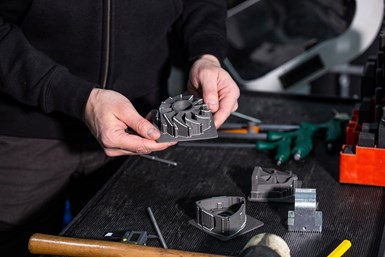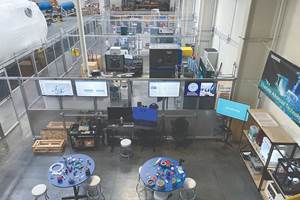Zortrax Offers Metal Systems for Producing Complex End-Use Parts
In addition, the company also offers Victrex AM 200 filament, which has a lower melting point than PEEK and can be extruded in lower temperatures.
Zortrax’s Endureal industrial 3D printer comes in two comprehensive sets for metal 3D printing — the Full Metal Package 17-4 PH and Full Metal Package 316L. It is said each Zortrax Full Metal Package contains all the essentials for an easy start with metal 3D printing and includes either BASF Ultrafuse 316L or BASF Ultrafuse 17-4 PH, which are metal-polymer filaments from BASF Forward AM.
In addition, the company also offers Victrex AM 200 filament, which has a lower melting point than PEEK and can be extruded in lower temperatures. This low-melt PAEK filament is a high-performance polymer from the same thermoplastics family as Z-PEEK, which offers similar, or in some areas, even better 3D printing results, the company says.
Zortrax Full Metal Package 316L includes BASF Ultrafuse 316L, a filament composed of 80% 316L stainless steel and 20% polymer. The 316L is a surgical-grade stainless steel, containing over 10% of chromium. This chemical element, while in contact with oxygen, causes a thin coating layer to form on the surface of the model, protecting it from corrosion. The company says the parts 3D printed with this material have up to 561 MPa tensile strength, 251 MPa yield strength, up to 53% elongation at break and have a nonmagnetic microstructure. All these features make this metal-polymer filament well suited for 3D printing complex end-use parts, automotive parts, medical equipment, chemical pipes or valves, elements of tools and fixtures as well as various functional prototypes.
Zortrax Full Metal Package 17-4 PH contains BASF Ultrafuse 17-4 PH, an industrial composite filament, comprising 80% of 17-4 hardened steel and 20% of polymer content. Models 3D printed with this filament are characterized by up to 1004 MPa tensile strength, 764 MPa yield strength, up to 4% elongation at break and have a magnetic microstructure. This material can be used for parts that require significant hardness, including chemical pipes or valves, strong metal end-use parts, medical equipment, automotive parts, elements of tools and fixtures, and functional prototypes.
Both packages include the BASF Ultrafuse support layer, which is a dedicated support material for ensuring the desired geometry of the printed parts during the 3D printing and postprocessing stages; Magigoo Pro Metal adhesive to provide reliable adhesion during printing and the easy removal of the printed part; an extra hotend module with brass nozzles for Zortrax Endureal; and a voucher for professional postprocessing in Elnik company (BASF’s partner in Germany), where 3D prints undergo crucial sintering and debinding processes to achieve all the properties of steel.
Another product introduced for Zortrax Endureal is Victrex AM 200 low-melt PAEK filament, a high-performance polymer that belongs to the same thermoplastics’ family as Z-PEEK. The most important features of the materials include low viscosity, assuring easier flow through the nozzle, slow crystallization rate facilitating strong interlayer bonding that improves tensile strength along the Z-axis, high dimensional stability, and minimized warpage.
The material is well suited for manufactured parts that require chemical resistance, significant mechanical strength and need to withstand extreme temperatures. The polymer combines all the advantages of PEEK and adds other benefits such as higher strength values, especially in the Z-axis, less shrink and warpage and soluble support compatibility. Moreover, it features a wider process window which can improve production outcomes and offer further design freedom.
- Read how Zortrax’s trio is a complete resin 3D printing and postprocessing system, including the Zortrax Inkspire 2 UV-LCD 3D printer, Zortrax Cleaning Station and Zortrax Curing Station.
- Learn how ML Systems saved up to two weeks of lead time and up to 90% of prototype fabrication costs by using Zortrax’s M300 Plus 3D printer to print prototypes in-house.
Related Content
Robot Vs. Gantry for Large-Format Additive Manufacturing (Includes Video)
Additive Engineering Solutions, specialist at 3D printing very large parts and tools on gantry machines, now also uses a robot for large-format AM. Here is how the robot compares.
Read MoreLouisville Slugger Uses Formlabs Technology to Accelerate Innovation
Louisville Slugger relies on Formlabs’ Form 3 stereolithography 3D printer to create both prototypes and manufacturing aids for designs of the composite and aluminum bats swung by youth and collegiate players.
Read MoreSavage Automation Delivers 3D Printed Commercial Manufacturing Aids
The company's approach to designing end-of-arm tooling and other devices has evolved over the years to support longevity and repairs.
Read MoreAdvancing Additive Manufacturing With a CATCH and Release Approach
Solutions for energy efficiency, sustainability, part repair and more are developing at Siemens’ Charlotte Advanced Technology Collaboration Hub (CATCH) in North Carolina.
Read MoreRead Next
Profilometry-Based Indentation Plastometry (PIP) as an Alternative to Standard Tensile Testing
UK-based Plastometrex offers a benchtop testing device utilizing PIP to quickly and easily analyze the yield strength, tensile strength and uniform elongation of samples and even printed parts. The solution is particularly useful for additive manufacturing.
Read MorePostprocessing Steps and Costs for Metal 3D Printing
When your metal part is done 3D printing, you just pull it out of the machine and start using it, right? Not exactly.
Read More3D Printed Polymer EOAT Increases Safety of Cobots
Contract manufacturer Anubis 3D applies polymer 3D printing processes to manufacture cobot tooling that is lightweight, smooth and safer for human interaction.
Read More





















